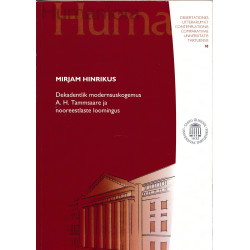



Tartu : Tartu Ülikooli Kirjastus, 2011
327 pages
Dissertationes litterarum et contemplationis comparativae Universitatis Tartuensis, 1406-913X ; 10
ISBN 9789949197248
Softcover in very good condition book
This doctoral dissertation examines the representation of different aspects of the modernization process in key literary texts of the Young Estonia movement: the essay-novella „Ruth”, by J. Randvere (alias J. Aavik, 1909), the novel „Felix Ormus¬son” by Friedebert Tuglas (1915), and selected works by A. H. Tamm¬saare. These representations of modernity are mediated by discourses of modernity: ways of perceiving, thinking, and speaking the experience of „being modern”. The focus of the dissertation, which consists of seven published articles and an extended introductory chapter, is specifically on the discourse of decadence, the impact of which is readily discernible in the literary works and criticism of the three authors. Recent research has emphasized that discourses of modernity are gendered discourses; a second argument of the dissertation thus explores the relations between the discourse of decadence and the discourse of antifeminism in the works of the three Estonian writers. This dissertation approaches decadence using methods drawn from post¬struc¬tu¬ralism and discursive cultural analysis, derived from dialogue with Finnish, Anglo-American and German researchers of decadence, who them¬selves have adapted Foucauldian approaches to analyze the discursive structure of decadence in literary texts of the turn of the 19th/20th century (Spackman 1989; Lyytikäinen 1997, 2003, Molarius 2003, Constable et al 1999; Kafitz 2004; Potolsky 2005, Morley 2005). The first article (I) included in the dissertation is the most recent, and con¬sists of a reading of two of A. H. Tammsaare’s works by means of and through its instantiations of the discourse of decadence. The following two articles (II and III) are concerned with the immensely popular and widely read mediator of antifeminism and decadence, Otto Weininger, whose text Geschlecht und Charakter (1903) was also read with curiosity and interest in Estonia. Weininger’s text sharply out¬lined gender typology within decadence and other gendered structures of the discourse; the two articles explore the dissemination and dispersion of Weinin¬ger’s discursive repertoire in the texts of A. H. Tammsaare and in the „sympto¬matic text” by J. Randvere. The next three articles (IV, V and VI) are com¬parative analyses of Tuglas, Randvere and Tammsaare with various foci, inclu¬ding gender and the structure of sensibility known from the French symbolists as „spleen”. The final article (VII) concerns the analysis of decadent discourse and the reception of Hippolyte Taine’s literary positivism in Aino Kallas’ essay collection „Young Estonia: Portraits and Outlines”, a retrospective on the Young Estonia authors and their intellectual matrix (1918).